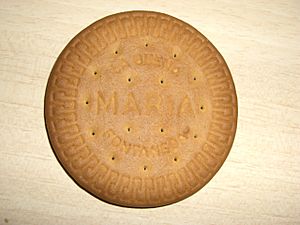Galletas Fontaneda facts for kids
 |
|
| Industry | Food processing |
|---|---|
| Founded | 1881 |
| Headquarters | , |
| Products | Cookies Biscuits Crackers |
| Revenue | |
| Total assets | |
|
Number of employees
|
|

Fontaneda is a famous Spanish company that makes delicious crackers and biscuits. In North America, biscuits are often called "cookies." For many years, Fontaneda was one of the biggest biscuit makers in Spain.
The company started in 1881 in a town called Aguilar de Campoo. A man named Eugenio Fontaneda founded it. Later, in 1996, a large international company called Nabisco bought Fontaneda. In 2002, the original factory closed, but the Fontaneda brand continued to make biscuits in other places.
Today, the Fontaneda brand is sold by a big company called Mondelēz International. The old factory building in Aguilar de Campoo was taken over by another company, Grupo Siro. They continued making biscuits there for a while. Aguilar de Campoo is even known as "the biscuit town" of Spain because so many biscuit factories are there!
Contents
The Story of Fontaneda Biscuits
How It All Began
Eugenio Fontaneda y Millán was a baker from Burgos, Spain. He learned how to make sweets and biscuits in another town called Reinosa. In 1881, he started his own business in Aguilar de Campoo. At first, he made biscuits, cookies, and chocolates by hand.
Around 1920, Eugenio bought a bigger building. This is where his famous factory would be. He started making the popular "galleta María" using machines. He even brought new technology from Switzerland and Germany.
A New Generation Takes Over
When Eugenio passed away in 1921, his son, Rafael Fontaneda e Ibáñez, took over the company. Rafael was very important in making Fontaneda a big success. He started making biscuits on a production line on March 25, 1923. The company was then called "Manufactura nacional de galletas, chocolates y bizcochos Hijo de E. Fontaneda."
Rafael hired skilled biscuit makers from other parts of Spain. This helped Fontaneda create many different types of biscuits. By 1927, Fontaneda was the top company for María biscuits in Spain. By 1933, the factory could make three times as many biscuits!
The Famous María Biscuit
The "María" biscuit is very famous in Spain. For a while, people thought it was named after Eugenio Fontaneda's granddaughter. However, the biscuit was actually created in London in 1874. It was named after Grand Duchess Maria Alexandrovna of Russia. She was marrying the Duke of Edinburgh at the time.
Growing Through Challenges
Sales of María biscuits grew very quickly in many parts of Spain. By 1936, the factory had five ovens. However, the Spanish Civil War slowed things down. In the 1940s, it was hard to get ingredients. But Rafael Fontaneda was a smart businessman. He found ways to get the materials needed.
Fontaneda also benefited from government rules that helped companies with their own sugar farms. Fontaneda had large sugar beet and sugar cane farms. By the 1950s, Fontaneda was the biggest biscuit company in Spain.
Modernizing the Factory
In 1952, Rafael Fontaneda updated the factory's machines. This cost a lot of money. He even traveled to the United States to learn about the newest ways to make biscuits. Fontaneda's success also helped other biscuit factories start in Aguilar de Campoo. These included Galletas Gullón and Galletas Fontibre.
In 1958, a fire damaged part of the factory. Rafael had to spend more money to rebuild it. The factory was in the middle of Aguilar de Campoo. It was a symbol of Fontaneda and provided many jobs for the people in the town.
The Third Generation
Eugenio Fontaneda y Pérez, Eugenio's grandson, became involved in the company. He also helped develop the town of Aguilar de Campoo. His father, Rafael, passed away in 1976.
Leaders of Fontaneda
- 1881–1921 Eugenio Fontaneda Millán
- 1921–1976 Rafael Fontaneda Ibáñez
- 1976–1996 José Fontaneda y Pérez
See also
 In Spanish: Galletas Fontaneda para niños
In Spanish: Galletas Fontaneda para niños

